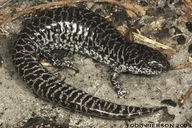|
Description
The Flatwoods salamander (Ambystoma cingulatum) was first described by Cope in 1868 but has remained rare in museum collections to this day. This species is a small, slender species of Ambystoma with a light gray reticulate or frosted pattern on a dark gray or black dorsum (Petranka 1998),
though gulf coast populations often have a brownish gray reticulate pattern on the dorsum. The venter is typically dark gray with a light gray flecking or spotting pattern present. Adults may reach lengths of 13.5cm in total length (TL) (Palis 1996)
with an average of 15 costal grooves in a range of 13-16. Larvae develop a yellow - gold vertebral stripe along the length of the body shortly after hatching. Hatchlings are identified by their uniformly dark brown dorsal patterning and their pale brown venter. Hatchlings typically measure 7.5-11.5 mm SVL and 10-19 mm TL (Anderson and Williamson 1976; Palis 1995).
Distribution and Habitat
Country distribution from AmphibiaWeb's database: United States U.S. state distribution from AmphibiaWeb's database: Florida, Georgia, South Carolina
Ambystoma cingulatum has a very narrow distribution occupying seasonally wet, pine flatwoods and savannas from southern South Carolina, southern Georgia, and northern Florida west to southern Alabama (Petranka 1998).
Prior to European settlement Ambystoma cingulatum was found primarily in seasonally wet, longleaf pine (Pinus palustris)-wiregrass (Aristida stricta) communities. Populations are discontinuous and rapidly becoming fragmented throughout the range as longleaf pine habitat is destroyed and replaced with slash pine. There may have been extirpations occurring in Alabama, and recent work suggests the extirpation of a sizable breeding population in a period of approximately 22 years (Means et al. 1996).
Life History, Abundance, Activity, and Special Behaviors
This species breeds in ephemeral ditches, including roadside ditches and pasture ponds, in addition to pond cypress and black gum habitat. The flatwoods salamander is a fall breeder. Adults typically migrate to breeding sites during rains from mid-October through early February (Means et al.1996).
Courtship has not been observed, but it is believed that individuals court on land. Ambystoma cinglatum is one of only two species (see A. opacum) of mole salamanders that are known to court and deposit eggs in terrestrial habitat. Individuals leave the breeding site near their entry point after a period of approximately 38 days. Females deposit 1-34 clumped eggs at or near the water's edge in depressions. As in A. opacum, hatching is triggered as rains that fill the pools inundate the eggs. Females from populations in southern South Carolina and into Georgia have been shown to deposit eggs singly under logs, leaf litter, and sphagnum mats (Anderson and Williamson 1976).
Trends and Threats
Habitat fragmentation and destruction are rapidly affecting the flatwoods salamander. The longleaf pine-wiregrass communities that once dominated the Coastal Plain from North Carolina to east Texas are rapidly being destroyed for slash pine silviculture practices. It is estimated that the longleaf pine forests once comprised 60.6% of the upland landscape prior to early settlement, yet by 1990 it had dropped to 1.4% of the landscape (Ware et al. 1993).
Despite earlier controversy about whether the flatwoods salamander preferred the slash pine habitat, Means et al. (1996)
demonstrated that adult members of the species are primarily inhabitants of the longleaf pine-wiregrass flatwoods, and that the slash pine flatwoods only form a small portion of the adult habitat.
Relation to Humans
The flatwoods salamander is a species with a relatively restricted range and specific habitat requirements. The longleaf pine communities, which were once the dominant upland habitat type in the coastal plain from North Carolina to east Texas, have declined by more than 50% since presettlement times. Silvicultural practices have driven this habitat destruction resulting in the fragmentation of the remaining flatwoods salamander populations and potentially other species dependent on these communities. Thus, the species provides an example where reevaluating the impact economic forestry practices may have on species may be warranted.
Possible reasons for amphibian decline General habitat alteration and loss
Habitat modification from deforestation, or logging related activities
Intensified agriculture or grazing
Subtle changes to necessary specialized habitat
Predators (natural or introduced)
Comments
The species epithet, "cingulatum," is from the Latin word for “girdle,” which is "cingulum", and presumably refers to the coloration of the intercostal grooves that are mentioned in the original description (Tighe 2023).
Amblystoma lepturum was downgraded to subspecies of A. cingulalum while Ambystoma bishopi was elevated to full species from a subspecies of A. cingulalum (Tighe 2023).
References
Anderson, J. D., and Williamson, G. K. (1976). ''Terrestrial mode of reproduction in Ambystoma cingulatum.'' Herpetologica, 32, 214-221.
Means, D. B., Palis, J. G., and Baggett, M. (1996). ''Effects of slash pine silviculture on a Florida population of Flatwoods Salamander.'' Conservation Biology, 10(2), 426-437.
Palis, J.G. (1995). ''Larval growth, development, and metamorphosis of Ambystoma cingulatum on the Gulf Coastal Plain of Florida.'' The Florida Scientist, 58(44), 352-358.
Palis, J.G. (1996). ''Flatwoods Salamander (Ambystoma cingulatum Cope). Element stewardship abstract.'' Natural Areas Resource Journal, 16, 49-54.
Petranka, J. W. (1998). Salamanders of the United States and Canada. Smithsonian Institution Press, Washington D.C. and London.
Tighe, K.A. (2023). Catalog of type specimens of recent Caudata and Gymnophiona in the National Museum of Natural History, Smithsonian Institution. Smithsonian Contributions to Zoology 654.
Ware, S.C., Frost, C. and Doerr, P.D. (1993). ''Southern mixed hardwood forest: the former longleaf pine forest.'' Biodiversity of the Southeastern United States. W.H.Martin, S.G. Boyce, and A.C. Echternacht, eds., John Wiley and Sons, New York, 447-493.
Originally submitted by: Mark D. Cooperman (first posted 2003-01-09)
Edited by: Meredith Mahoney (2023-08-11)Species Account Citation: AmphibiaWeb 2023 Ambystoma cingulatum: Frosted Flatwoods Salamander <https://amphibiaweb.org/species/3830> University of California, Berkeley, CA, USA. Accessed Apr 26, 2024.
Feedback or comments about this page.
Citation: AmphibiaWeb. 2024. <https://amphibiaweb.org> University of California, Berkeley, CA, USA. Accessed 26 Apr 2024.
AmphibiaWeb's policy on data use.
|





 Raffaëlli Account
Raffaëlli Account Map of Life
Map of Life